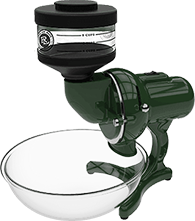In 1915, potassium bromate (KBrO3) was patented for use in bread baking1. It is an oxidizing agent that ages flour faster than air does, increasing the strength and elasticity of dough1,2. The bread that bromated dough makes is extremely white, soft and fluffy. As good as that might sound, potassium bromate is banned in the United Kingdom, Europe, Canada, Brazil, China and many other countries4 as research in Japan in 1990 found that the additive caused thyroid and kidney cancer in rats and mice3.
However, it is still allowed in the United States and used in various commercially baked products and flour. In 1991, the state of California began requiring warning labels for products that contain potassium bromate4. For non-California residents, searching the ingredient list on products for “potassium bromate” or “bromated flour” will help consumers avoid this additive, as California is the only state to take such measures.
Identifying potassium bromate while dining out is even more challenging. Pizza, for example, used to be very much made by hand. It’s nostalgic to see a baker throwing pizza dough into the air simply because it’s not a very common practice in restaurants anymore. Eventually, to make more pizza, faster, the process was changed and restaurants began using premade crusts, or, if they made their own, they would possibly use bromated flour due to its ability to make a faster rising dough that produced a whiter, softer crust. In either case, the quality of the dough is questionable, and often we consume this kind of food without having any idea that we might be ingesting something that other countries don’t allow.
Is there an easier way to make sure you’re not eating questionable additives?
Milling your own flour ensures you will never have to check labels or be concerned about oxidizers like bromate or bleaching agents like azodicarbonamide5. Milling your own flour means you will always have 100% whole grain flour, including the germ and the bran, bringing you the full nutrition that whole grains provide. That’s Intelligent, Healthful Living®.
References
- Kohman, Henry A., Charles Hoffman, and Truman Godfrey. Manufacture of Bread. Adams Charles, assignee. Patent US1148328A. 27 July. 1915. Print.
- Henika, Richard G., and Nelson E. Rodgers. Process for Making Yeast Leavened Bakery Products and Composition Therefor. Richard G Henika, Nelson E Rodgers, assignee. Patent US3053666A. 11 Sept. 1962. Print.
- “Toxicity and Carcinogenicity of Potassium Bromate–a New Renal Carcinogen.” National Center for Biotechnology Information. U.S. National Library of Medicine, n.d. Web. 02 Nov. 2016. <https://www.ncbi.nlm.nih.gov/pubmed/2269236/>.
- Aguayo, Jose, and Nneka Leiba. “POTASSIUM BROMATE. Was Your Bread Baked with Flour Containing a Possible Cancer-causing Additive?” Potassium-Bromate. Ewg, 15 Oct. 2015. Web. 02 Nov. 2016. <http://www.ewg.org/research/potassium-bromate>.
- “Frequently Asked Questions on Azodicarbonamide (ADA).” Frequently Asked Questions on Azodicarbonamide (ADA). N.p., n.d. Web. 02 Nov. 2016. <http://www.fda.gov/Food/IngredientsPackagingLabeling/FoodAdditivesIngredients/ucm387497.htm>.

